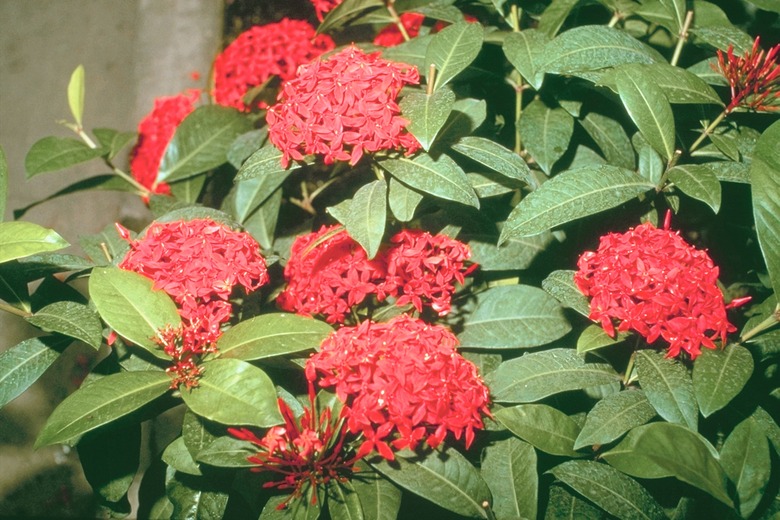Dwarf Ixora Diseases
Ixora is an evergreen shrub that is related to gardenias. It produces clusters of red, yellow and pink flowers with tubular throats. Sometimes the flowers produce edible purplish-black berries, but they are not very tasty. Dwarf ixoras have tiny leaves and seldom grow more than 3 feet tall. They are easy to grow and maintain, although they are susceptible to some diseases.
Step 1
Bacteria is normally present on ixora shrubs, and only causes a problem under certain conditions such as when plants are overcrowded or if the humidity's too high and air circulation is poor. Bacterial leaf spots cause light green, water-soaked spots to appear on young leaves. As the disease progresses, the centers of the spots dry, turn brown and die. Spots may merge to form large dead areas, surrounded by irregular yellow margins. In addition, the leaves may become distorted.
Root Rots
Step 1
Mushroom root rot, or armillaria root rot, can kill dwarf ixora shrubs quickly. The fungi commonly live in soil and attack shrubs that are weakened or stressed. Look for white fungal mats growing under the bark at or just above the soil line. Long, black, rootlike structures called rhizomorphs can often be found on infected roots, root collars and in surrounding soil. Additional symptoms include discolored leaves, limb dieback, woody tissue decay and reduced shoot growth.
Step 2
- Bacteria is normally present on ixora shrubs, and only causes a problem under certain conditions such as when plants are overcrowded or if the humidity's too high and air circulation is poor.
- Long, black, rootlike structures called rhizomorphs can often be found on infected roots, root collars and in surrounding soil.
Sooty Mold
Step 1
Sooty mold is one of the more common diseases that dwarf ixoras are prone to develop, and is a result of insect infestations from aphids and scales. These insects feed on plant sap and excrete a sticky substance called honeydew, which attracts the growth of sooty mold. Symptoms include the appearance of a sooty black coating on the leaves, fruits and branches. The mold may be velvety or crustlike, and can easily be removed by rubbing it off. It is considered to be an aesthetic problem because it doesn't kill plants or parasitize them. However, sometimes it can grow so thick that it interferes with their ability to do photosynthesis, causing stunted leaves and shoots.
Control
Step 1
Bacterial leaf spots can't be completely cured, but can be treated with copper sulfate and streptomycin sulfate to achieve a moderate level of control. Fungicides are ineffective in treating mushroom root, but the disease can be slowed down, if it is caught before the roots are seriously damaged. Remove dead bark and soil from around the root collar and leave it exposed to air for several months. Severely damaged shrubs, including the stumps and roots, should be removed. Spray water on your shrub to remove sooty mold and consult your local county extension for help in identifying the insect infesting your dwarf ixora.
Step 2
- Sooty mold is one of the more common diseases that dwarf ixoras are prone to develop, and is a result of insect infestations from aphids and scales.
- Bacterial leaf spots can't be completely cured, but can be treated with copper sulfate and streptomycin sulfate to achieve a moderate level of control.
References
- University of Florida Extension; Choose Ixora For Year Round Color; Daniel F. Culbert; May 2001
- Alabama Cooperative Extension; Armillaria Root Rot of Trees and Shrubs; Jacqueline Mullen, et. al.
- Ohio State University Extension Fact Sheet; Sooty Mold on Trees and Shrubs; Stephen Nameth
- University of Minnesota; Bacterial Leaf Diseases of Foliage Plants; F.L. Pfleger, et. al.; 2011
